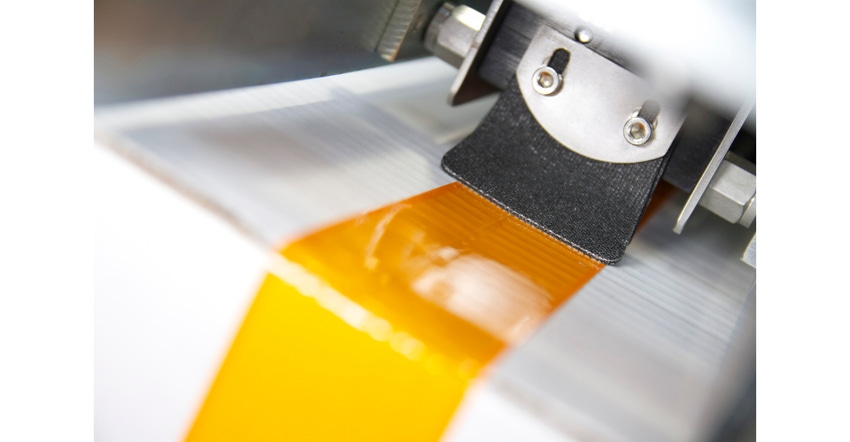To ensure an efficient case-sealing operation and a secure seal, consider the case’s surface and environment throughout its use, along with the grade and quality of the tape you select.

Packaging tape is a critical element of manufacturers’ secondary packaging strategies. When it comes to ensuring goods arrive safely and securely to their final destination, tape is as important as the box chosen for shipping and the cushioning protecting products.
Selecting the correct packaging tape prevents failing, flagging, and broken tape. It also saves time and money that could be lost to rework, returns and reshipping. When deciding which tape will meet the supply chain’s demands, take these four factors into consideration.
1. Substrate.
Manufacturers need to pay careful attention to the surface of the carton and how the tape will adhere to that surface. Different types of corrugated cartons include recycled, thick or double-wall, and printed or waxed options.
• Recycled cartons are prevalent in the industry and may be difficult to seal securely due to the short fibers that make up the substrate. The chopped-up and repulped fibers are tightly packed together, creating a less porous surface than that of a 100% virgin fiber carton. For recycled cartons, a specialized tape with an enhanced adhesive is necessary. Hot melt packaging tapes have specific formulations that provide higher shear, tack, and adhesion.
• Thick or double-wall cartons require a tape that resists slippage and has the ability to stick to the sides of the carton and hold the major flaps down. A carton’s major flaps have more memory and transfer stress to the tape once the carton is sealed. Hot melt tapes have the high holding power required to keep the major flaps down and prevent tape flagging.
• Printed or waxed cartons present an entirely different challenge for packaging tape. These substrates have a low surface energy. Since the molecular force of attraction is lower, adhesives do not easily establish a bond with the carton’s surface. Acrylic tapes have a lower viscosity adhesive, which is able to wet out — the adhesive flows and covers the surface to maximize the contact area — and permeates the carton’s printed or waxed layer.
2. Environment.
It is important to consider the environmental conditions that cartons will endure throughout the production, shipping, and storage timeline. Cold packaging environments are not tape friendly. Due to adhesive’s viscoelasticity — the combination of both liquid and solid properties — cold temperatures cause the liquid component in the adhesive to harden and the tape loses its tackiness. Hot melt tapes are formulated with a special synthetic adhesive to create an instant, permanent bond that resists subfreezing temperatures.
On the opposite end of the spectrum, humidity is also an issue for tape. For hot, humid environments, manufacturers should choose an acrylic tape, which also works well in dusty or dirty environments. The tape’s ability to wet out, or be more liquid-like, allows the adhesive to move around dirt and dust. This feature lets acrylic tape form a robust bond with the case.
3. Tape Grade.
Packaging tapes are available in a variety of film thicknesses and adhesive levels. To ensure they have the right tensile strength and holding power for a particular application, manufacturers should “right-size” their packaging. Use the case’s size and weight as guidelines in selecting the proper grade of tape. As these factors increase, the tape grade should increase as well. For example, lower grade tapes that offer thinner backings and lower levels of adhesive often are used for lightweight case sealing, while higher grade tapes offering thicker backings. Higher levels of adhesive are typically recommended for larger, heavier weighted cases.
4. Tape Quality.
Quality packaging tape goes through rigorous testing to ensure it can maintain a strong hold without failing. A well-manufactured tape ensures a secure seal and high productivity, allowing lines to run faster and longer. This improves bottom lines by reducing tape waste and reducing rework.
• Performance testing is regulated by the Pressure Sensitive Tape Council (PSTC), a 60-year old North American trade association for tape manufacturers and affiliate suppliers, and the American Society of Testing and Materials (ASTM). The ASTM is a not-for-profit global organization that provides a forum for the development and publication of consensus standards for materials, products, systems, and services in a variety of industries, including building and construction, food processing, manufacturing, and many more.
• Physical testing examines the tape’s peel, tack, and sheer. It includes evaluations of the tape’s shear strength and holding power, adhesion to fiberboard, tensile strength, and elongation — the percentage of stretch endured before the tape breaks.
• Transit endurance is tested by the International Safe Transit Association (ISTA). It regulates tests that include vibration testing — simulating the movement of packages during transport — as well as temperature and humidity testing, drop tests, and more.
Proper packaging tape reduces supply chain costs.
Making smart decisions on tape can make big impacts to the bottom line. Important factors that may be overlooked, such as how tape adhesive reacts to various surfaces and conditions and the quality of the packaging tape affect cost savings and customer satisfaction. By thoughtfully examining different aspects of the supply chain, manufacturers can ensure that they are selecting the most suitable packaging tape to meet their individual processing needs.
About the Author(s)
You May Also Like




